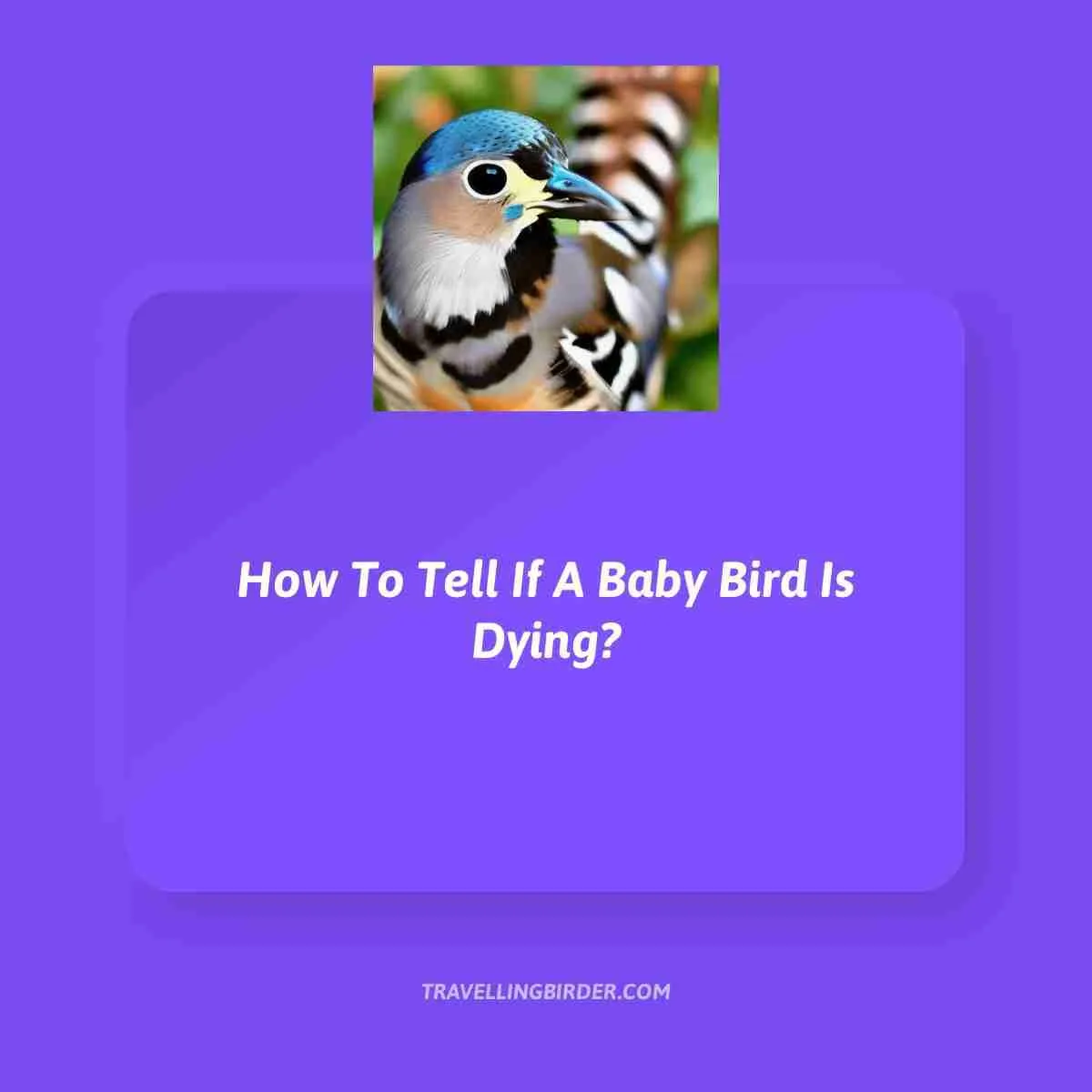It’s a heartbreaking sight – coming across a baby bird that appears to be in distress. Whether you’re an animal lover, a concerned citizen, or both, it’s natural to want to help the little creature.
Before taking action, though, it’s important to determine if the baby bird is actually dying or simply going through a normal stage of development.
In this article, we’ll provide some guidance on how to recognize signs that a baby bird may be struggling for survival and what steps you can take to assist them.
With these tips in mind, you’ll be better equipped to make informed decisions about when and how to intervene – potentially saving the life of one of nature’s most delicate beings.
Identifying Signs Of Distress
When observing a baby bird, it’s crucial to be able to identify signs of distress or illness symptoms that may indicate the bird is dying.
A few common distress behaviors include labored breathing, lethargy or weakness, loss of appetite, vomiting or regurgitating food, and an inability to maintain balance.
Additionally, if you notice discharge from the eyes or nostrils, this could also signal potential health issues.
Keep in mind that baby birds are fragile creatures; their condition can deteriorate rapidly without proper care.
With these warning signs in mind, let us now transition into assessing the bird’s development stage for further insight on its overall wellbeing.
Assessing The Bird’s Development Stage
It is a heartbreaking fact that nearly 80% of baby birds do not survive past their first year due to various factors, including illness and predation.
As such, it becomes crucial for bird rescuers and caregivers to understand the developmental milestones and observe nest behaviors in order to determine if a baby bird is struggling or dying.
- Developmental Milestones:
- Hatchlings (0-3 days old): Eyes closed, little or no feathers
- Nestlings (4-13 days old): Developing feathers, eyes open partially or fully
- Fledglings (14+ days old): Fully feathered, learning to fly
By observing these stages closely and comparing them with typical nest observation patterns like feeding frequency by parent birds, preening activities, and interaction among siblings, one can assess whether the baby bird’s development is on track or if there are signs of distress.
Being aware of these indicators will enable you to take appropriate action in case intervention becomes necessary. After evaluating the bird’s development stage, it’s essential to know how to provide immediate care should the need arise.
Providing Immediate Care
Providing immediate care to a baby bird in distress is crucial for increasing its chances of survival.
One important aspect is emergency feeding, which can be done by offering small amounts of wet dog or cat food using tweezers, making sure not to overfeed the little one as it can lead to complications.
In addition, hydration tips include providing clean water using an eye dropper or syringe without a needle and gently placing drops on the side of the bird’s beak so that it doesn’t inhale the liquid accidentally.
Keep in mind that while these measures might help stabilize the condition of the baby bird temporarily, they should never replace seeking professional help from a veterinarian or wildlife rehabilitator who will provide appropriate treatment and guidance.
Seeking Professional Help
Ironically, while you may feel like a superhero for saving and trying to revive the baby bird, there comes a time when even heroes need backup.
When you’ve done everything within your knowledge and power and the situation doesn’t seem to improve, it’s time to explore veterinary options or seek out rehabilitation centers.
These professionals have years of experience dealing with delicate wildlife cases like these and will be better equipped to determine how best to help the struggling little one.
Remember that in some instances, despite our sincerest efforts, nature might take its course; however, by seeking professional assistance, we can maximize their chances of survival.
Next up: let’s discuss what actions we can take as preventative measures for bird safety before such situations arise again.
Preventative Measures For Bird Safety
To ensure the safety and well-being of baby birds in your care or within your vicinity, it’s essential to take some preventative measures. Bird proofing homes is a practical way to reduce risks faced by these fragile creatures, while providing them with an environment where they can grow and thrive without harm.
Additionally, implementing nesting deterrents can help prevent unwanted bird-related issues around your property.
- Install window decals: These will make windows more visible to birds, reducing the risk of collision.
- Remove tempting perches: Trim tree branches and remove any unnecessary structures that may attract birds near windows or other hazardous areas.
- Provide alternate nesting sites: Place birdhouses away from danger zones like windows and busy traffic areas.
- Use bird repellents: Non-toxic sprays or gels can be applied on surfaces you wish to deter birds from accessing.
By taking these simple steps, you’ll not only contribute to the overall well-being of baby birds but also create a safer space for all wildlife around your home.
Frequently Asked Questions
What Are Some Common Illnesses Or Diseases That Can Cause A Baby Bird To Die Prematurely?
There are several common illnesses or diseases that can cause a baby bird to die prematurely.
Some of these include avian infections and parasite infestations, which if not treated promptly, can prove fatal for the young bird.
Avian infections such as respiratory issues or bacterial infections can hinder the growth and development of the baby bird, making them weak and susceptible to other health problems.
Similarly, parasite infestations like worms or mites may affect their physical condition by draining nutrients from their bodies, leading to malnourishment and inability to fight off potential threats.
In both cases, early detection and treatment play a crucial role in ensuring the survival of the affected baby birds.
How Can I Tell If The Baby Bird Is Suffering From Malnutrition Or Dehydration?
How can you identify if a baby bird is suffering from malnutrition or dehydration?
To spot malnutrition symptoms and dehydration indicators, observe the chick’s physical appearance and behavior closely. Malnourished chicks often appear weak, have poor feather growth, and may be underweight with visible bones through their skin. Additionally, they might display lethargy or struggle to hold their head up.
In contrast, signs of dehydration include sunken eyes, dry and wrinkled skin, as well as an unresponsive demeanor.
By carefully monitoring these signs in your baby bird, you’ll be better prepared to address any potential health issues related to malnutrition or dehydration.
Can I Feed A Baby Bird Human Food Or Do They Require A Specific Diet?
Feeding a baby bird human food is not recommended, as it can pose significant health risks to the fragile creature. Baby birds require specialized diets that cater to their specific nutritional needs, which are essential for proper growth and development.
Human foods often lack essential nutrients or contain ingredients that may be harmful to the delicate digestive systems of these young animals.
Instead of feeding them human food, opt for formulas specifically designed for baby birds or consult with a veterinarian or wildlife rehabilitator for guidance on providing appropriate nourishment tailored to the bird’s species and age.
Are There Any Specific Environmental Factors, Such As Temperature Or Humidity, That Can Negatively Impact A Baby Bird’s Health?
Just as a delicate flower wilts under harsh sunlight or withers in a cold breeze, baby birds can also suffer from temperature consequences and humidity hazards.
These environmental factors play a crucial role in the overall health and well-being of these fragile creatures.
Maintaining an optimal temperature is key to their survival, as extreme heat or cold may lead to thermoregulation issues, making it difficult for them to maintain normal body functions.
Similarly, high humidity levels pose respiratory risks that could threaten the young bird’s life.
Therefore, ensuring suitable conditions within their environment is vital for promoting growth and stability while simultaneously reducing potential threats to their health.
What Are Some Signs That A Baby Bird Is Experiencing Pain Or Discomfort, And How Can I Provide Relief?
Some signs that a baby bird is experiencing pain or discomfort include changes in vocalization, such as excessive crying, whining or peeping; physical indicators like lethargy, labored breathing, fluffed-up feathers or hunched posture; and behavioral shifts including refusal to eat, aggression or self-mutilation.
To provide relief for the baby bird, consider using gentle relieving techniques like providing a warm, quiet environment with appropriate humidity levels; offering soft foods rich in nutrients to encourage eating; and consulting an avian veterinarian for specialized medical care if you suspect any serious health issues.
Can I Use the Same Methods to Determine if a Baby Bird is Dying as I Would to Determine if a Bird is Stunned or Dead?
When assessing the condition of a baby bird, it is essential to employ different methods than those used for a bird stunned or dead. The signs indicating a baby bird in distress can include unresponsiveness, weak movements, or a lack of feeding by the parent. In contrast, determining if a bird is stunned or dead involves examining its posture, respiratory activity, and response to touch. Distinguishing between these situations is crucial in providing appropriate care for the bird.
Conclusion
In conclusion, the delicate dance of life for a baby bird teeters on a fragile balance. Illnesses, malnutrition, dehydration, and environmental factors can all play their part in snuffing out its tiny flame before it has a chance to soar.
As caretakers of these little creatures, we must be vigilant in recognizing signs of distress and pain.
By providing proper nourishment, tending to their environment, and offering relief when needed, we become guardians of hope that guide them towards taking flight into the vast sky above.

An avid ornithologist, zoologist and biologist with an unwavering passion for birds and wild animals.
Dr. Wilson’s journey in ornithology began in childhood and led him to obtain a Ph.D. in Ornithology from the prestigious Avian Research Institute. He has worked closely with renowned experts in the field and conducted extensive research and field studies globally.




